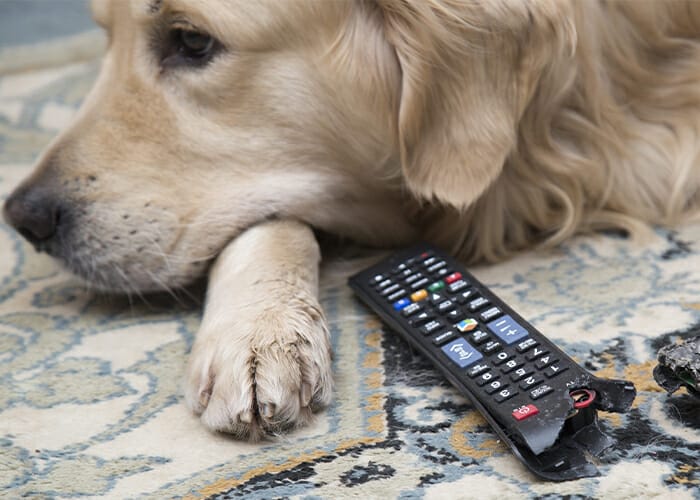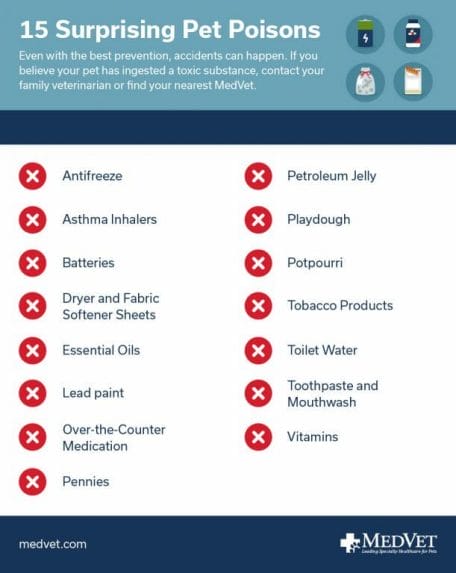15 Surprising Pet Poisons – Keep Your Pet Safe

We share a lot about foods and plants that are toxic to our pets. And many people are aware of the potential dangers of hand sanitizer, household cleaners, and chemicals for our furry friends. But there are more items in our homes that could cause pet problems. Here are 15 surprising pet poisons that might be in your home.
1. Antifreeze
Antifreeze contains ethylene glycol, which is deadly even in small amounts. With its sweet smell and taste, some pets have been known to drink it. Even if you’re storing the container safely, your pet may still encounter it. Small spills from changing fluids or a leaky radiator can leave puddles in the garage or driveway that can be lapped up by your pet.
Another hidden danger is the puddles on the side of the road. Water washed from driveways and streets pools at the side of the road and may contain traces of antifreeze or other automotive fluids. Always provide your pet with clean drinking water so they are not tempted to drink from puddles during walks.
2. Asthma Inhalers
Although Asthma inhalers can be lifesaving for humans, it is the opposite for pets. If a pet chews on the inhaler and punctures the container, all the medicine contained bursts out at once causing an overdose in your pet. The albuterol in an inhaler speeds your pet’s heart rate up to dangerous levels and lowers potassium levels in the blood. Ensure the inhalers are stored out of your pet’s reach or securely, such as in a zipped backpack, clutch, or handbag.
3. Batteries
You already know not to give your pet a battery, but don’t overlook the items they chew on containing batteries. Common items include electronic remotes and children’s toys. Your pet doesn’t have to swallow a whole battery; simply puncturing a battery while chewing can expose them to the dangerous alkaline and acidic compounds inside. Keep batteries and items containing batteries out of the reach of pets.
4. Dryer and Fabric Softener Sheets
Dryer and fabric softener sheets smell nice and are fun to shred, which makes them extra tempting for some pets. However, the chemicals used in the products to remove static cling can harm your pet. Even used sheets can be dangerous. So, keep these (and all) laundry products stored safely or switch to products like dryer balls.
5. Essential Oils
Essential oils have grown in popularity in recent years for aromatherapy, alternative medicine, and to scent home and personal care products. These are liquid concentrations of different plant products, which means some are more harmful to pets than others. Ingestion and skin exposure can cause issues. Speak to your veterinarian before burning or diffusing any essential oils in your home, and keep in mind that concentrated oils should never be applied direct to a pet’s skin or fur.
6. Lead Paint
Many homes built prior to 1978 contain lead paint. Chipped paint and even dust from walls can cause problems for your pet. You can get your home tested for lead paint and safely remove it. It’s poisonous for humans, too, so this helps make your home safer for all the members of your family.
7. Over-the-Counter Medication
It’s no surprise that prescription medicines and pets are not a good mix. But over-the-counter medication may not seem as dangerous. However, acetaminophen (Tylenol), ibuprofen (Advil and Midol), and naproxen (Aleve) are not made for pets and even small amounts can be toxic. Never give human medications to treat your pet unless directed by a veterinarian.
8. Pennies
Picking up pennies may mean good luck for humans, but not for pets. Not only are pennies a choking hazard, those minted after 1983 also contain zinc. This heavy metal can be absorbed by your pet and cause blood disorders. So, pick up those coins when you see them and put them in a bank, jar, or other safe place.
9. Petroleum Jelly
Petroleum jelly can be found in lotions, soaps, and makeup. Scented versions of many of these products can make them extra attractive to your pets. But the laxative properties of petroleum jelly can cause intestinal distress for your pet. Keep these products tucked away in cabinets or drawers your pet cannot access.
10. Playdough
This favorite childhood item can seem safe since it is labeled as non-toxic and safe for child’s play. Homemade and store-bought versions, however, can be dangerous, as are salt dough ornaments that are made during craft time. The danger is the high salt content which can lead to salt toxicity. Too much salt in the blood causes water to leave muscles and cells to try to dilute the salt in the bloodstream which can lead to dangerous levels of dehydration.
11. Potpourri
In dry form, potpourri is a mixture of dried plants and herbs. The potential toxicity depends on which plants were used to make the potpourri. Additionally, some have artificial colors or scents added through a variety of chemical compounds. Liquid and oil forms can be even more dangerous due to cationic detergents in the products. It is best not to leave pets unattended near any form of potpourri.
12. Tobacco Products
Nicotine is toxic to pets and can be found in cigarettes, nicotine patches and gum, and even e-cigarettes and refills. E-cigarette liquids are often also flavored making them irresistible to curious pets. Those products also have higher concentrations so a pet that gets into a package of e-cigarettes is being exposed to greater levels of nicotine.
13. Toilet Water
It can seem funny to see a pet drinking from the toilet, but toilet water is not safe to drink. Germs and bacteria can remain in the bowl well after human waste is flushed. Even a freshly cleaned toilet can be dangerous as there may be leftover chemicals from cleaning products. Keep the toilet lid down and provide fresh water for your pet elsewhere.
14. Toothpaste and Mouthwash
Many human oral care products contain xylitol. This sugar substitute is dangerous for your pet. It increases insulin production, causing dangerously low levels of blood sugar so take care to keep human care products away from pets and safely dispose of used tubes and containers in secured trash cans. In addition, always make sure you use toothpaste made just for pets when you are brushing their teeth.
15. Vitamins
Although our pets do need certain vitamins and minerals, the supplements and multivitamins we take as humans have concentrations that are much higher than what our pets need. In addition, some vitamins contain xylitol which can cause low blood sugar and liver damage. Make sure vitamins are stored in closed containers and away from pets.

No matter how much you’ve pet-proofed and how careful you are, accidents can happen. Pets can be very curious, and their sensitive noses can help them sniff out things we don’t even notice. Watch for signs of mischief in your home such as chewed containers or toppled trashcans. Signs of poisoning in your pet can include vomiting, diarrhea, upset stomach, lethargy, loss of appetite, drooling, abnormal behavior, excessive thirst or urination, weakness, or seizures.
What to do if you believe your pet has ingested poison
Stay calm but act quickly. Some toxins impact the body and escalate issues faster than others. Early treatment gives your pet the best chance to recover.
- Call your veterinarian, the Pet Poison Helpline at 855-764-7661, or come to your nearest MedVet Emergency Hospital right away. Save the number for Poison Control, your vet, and the nearest Emergency Hospital in your phone. You don’t want to have to search for numbers in the case of an emergency.
- Do not induce vomiting unless directed to do so by a professional.
- Be prepared to share what your pet was exposed to and try to figure out how much of an item they ingested.
- If you can, bring the packaging for the item. The ingredients listing or manufacturer’s information could be helpful.
Prevention is key
Keeping your curious pet healthy and out of the ER takes some careful planning and pet–proofing. Read labels before bringing items into your home. Choose pet-friendly versions of products when you can. For products that do not have pet-friendly versions, knowing how to properly store and safely use them is important. Always store potentially hazardous items in pet-proof areas of your home. And be careful when throwing items out that trashcans are not accessible to curious pets.
Pet Care Resources
For ways to ensure your pet lives a happier, healthier life, visit our Pet Care Resources library.
View ResourcesPet Care Resources
For ways to ensure your pet lives a happier, healthier life, visit our Pet Care Resources library.
View Resources